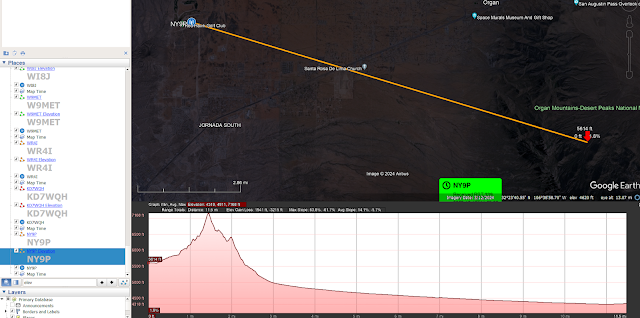Paradigm Shift: Seaparating Data from Views aka Elevation Profiles aren't Ham Radio QSO Database Material
I've been slowly but surely working through this week's ham radio QSO elevation profile project. The way I want to use the tool (Datasette) doesn't feel like a good fit for the tool. That's made things more difficult. In short, here's what I hope to achieve:
- Plot a partial QSO path for each contact from the transmitting station (me), about 10 wavelenghts or so out towards the receiving station, so about 200 meters or so in this case. This path should be on the kml map of the QSO This is done.
- Place a png picture of the elevation profile into the Datasette row for that QSO.
- This is what this post was about.
- Add this picture to the kml map as well.
So! I think I was wrong! The point of this whole operation was to have elevation profiles directly available in kml animated maps. I wanted them to be automatically included with each QSO, but my ownw specification was that they should be in the map. Not the database!
Basically, there's data, the dates, times, callsigns, and RST reports of QSOs. And then there's visulaizations of data. Things like animated KML maps, maps of F2 skips,
and elevation profiles.
The database does not contain raw map data. It aslo does not inlcude F2 data. Especially in the case of F2 data, one day the database might contain it, but for now, the point of maps, F2 skips, and elevation profiles, (and sometimes weather radar), is to visualize what was going on during the QSO.
Now that I'm thinking about a better separation of concerns, the application has also become more simple. Where the elevation profiles belong is in the already existing—but not quite released—kml plugin. Here's how things will work:
- The kml plugin code will calculate the partial path, (or more likely, just require them as a field in the query).
- Given the partial path endpoint, the kml plugin will call out for the elevation data.
- Using the returned elevation data, the plugin will create a google chart visualization, targeting it to a 'who cares' div added to the Datasette page.
- I say 'who cares' because the real point of the chart will be to call my_chart.getImageURI to return a png of the map in text form that can be inserted in the kmkl without needing to turn it into a kmz file.
- The reason to care about that is that most people looking at the maps do not have access to Google Earth Pro. I think it's free at this point, but it's still an extra install. Most people do have access to Google Earth Web where I can put direct links to the kml files displayed in Google Earth Web. (Whether or not the text data encoded pictures will work there remains to be seen.)


Comments
Post a Comment
Please leave your comments on this topic: